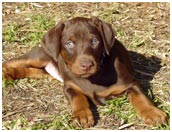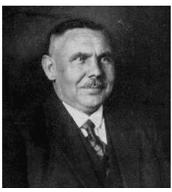
“only in the spirit of love, sacrifice and great cost will we bring our breed to a state of genetic excellence” Philipp Grünig
Philipp Grünig
“Judge, scientific breeder and profound student of the Dobermann”


“only in the spirit of love, sacrifice and great cost will we bring our breed to a state of genetic excellence” Philipp Grünig
Philipp Grünig
“Judge, scientific breeder and profound student of the Dobermann”
Please Note: The following article is reprinted with permission in its entirety from Gary Hutchison of Westwind GSP's and may not be reproduced elsewhere. The original article is available at www.westwindgsps.com/motherlines.htm.
This article was originally written in the 1930s by Dr. Kleemann (by whom the German Kleemann Seiger or KS tests were developed and for whom they are named. It was first reprinted in the Kurzhaar Blatter in August of 1962 then subsequently translated into English and reprinted in the GSP News in 1963. Once again it has been reprinted here (after being edited for brevity) for your review.
What is the meaning of "Motherlines?" The idea is too often confused by breeders with "motherside" or the bottom side of a pedigree ... but Motherlines is the whole of the bloodlines of all the mothers, including the father's mother and the other mothers on the father's side of the pedigree - but always the mothers ...
[the success of Motherline breeding comes from utilizing very important sex-linked genes present only in the additional DNA of the X chromosomes of great producing (Stamm) females ... since a male dog has 76 paired chromosomes plus an X and a Y chromosome the only place a male can inherit these important sex-linked genes is through his mother ... therefore; when this son becomes a father only his resulting daughters (never his sons) get this valuable X chromosome back again (along with another X chromosome from their own mother) ... in turn, when these resulting grand-daughters become mothers the art of breeding lies in selecting only the male offspring that inherited this valuable X chromosome (as these great-grandsons will be able to pass the important sex-linked genes on to their get) ... in so doing we bring the influence of the Stamm female (through this valuable X chromosome) to the topside of the pedigree and dramatically improve our chance of producing great pups true to type when we breed to quality females from the same Stamm line ... thus the importance of having an unbroken Motherline on both sides of the pedigree]
Pedigrees only serve as a guide to show us what "blood" could be carried by certain animals. Only through careful study of a particular animal's offspring and intimate knowledge of its ancestors can we determine what "blood" an animal is actually carrying. It is necessary to breed both according to bloodlines and performance to achieve success. We are looking for animals who are outstanding performers within the same bloodline.
It is only by inbreeding that we can double up on the good and bad qualities so we can see what we are dealing with. When faults in the line come to the surface we can skim them off and get rid of them. By out-crossing we only cover up the faults and reduce our knowledge of what to expect in subsequent litters. Anyone who condemns inbreeding must in turn condemn the detective who brings crimes to light as well as the messenger who brings bad news.
A good broodbitch is feminine ... of finer build, a light and pretty head with a smaller and thinner neck, lots of nobility, but also depth for growing pups. You should be able to recognize a good broodbitch at 100 meters and not find it necessary to look between her hips to tell her sex. Often I have seen young bitches which looked like grown males receiving much attention and being considered as future outstanding broodbitches. These bitches never lived up to expectations.
And then there is Herta von der Maylust who was considered a "cat" at shows because of her fine build and light bone structure and was advised not to be bred because (it was thought) she would only produce poor small puppies. Yet Herta is a Stamm (original ancestor) mother behind many of our great dogs today.
If you have a bitch you must select a stud with complimentary motherlines. It is much simpler if you have a bitch from a great motherline so that you can profit from the long experience of breeders in that motherline and have little difficulty in choosing a good stud dog. With a little known motherline it is difficult to find the proper mate since there is but a small number of dogs to choose from. Look for a pup with a continuous motherline from known performers.
When sire and dame have the same motherlines you can generally count on outstanding pups and you will have classy breeding stock. To improve your motherline you must bring together matching bloodlines holding fast to the good qualities and abolishing the bad. You then breed for performance, boldness, conformation, nose and waterwork. The Shorthair must be able to hunt for hours without tiring, he must have an outstanding nose and never give up on the retrieve of wounded game regardless of the distance.
Dr. Kleemann had been dead for 20 years when this article was first published which was nearly 40 years ago. We all owe a great debt to Dr. Kleemann for his artistic ability to pick the right breeding stock when the breed was still very young and his willingness to put his keen observations in writing for the rest of us to follow.